- Home
- About Us
- Industry
- Services
- Reading
- Contact Us
Artificial Intelligence in Supply Chain Market: Current Analysis and Forecast (2024-2032)
Emphasis on Application (Fleet Management, Supply Chain Planning, Warehouse Management, Virtual Assistant, and Others); By End-User (Automotive, Retail, Consumer-Packaged Goods, Food and Beverages, and Others); and Region/Country
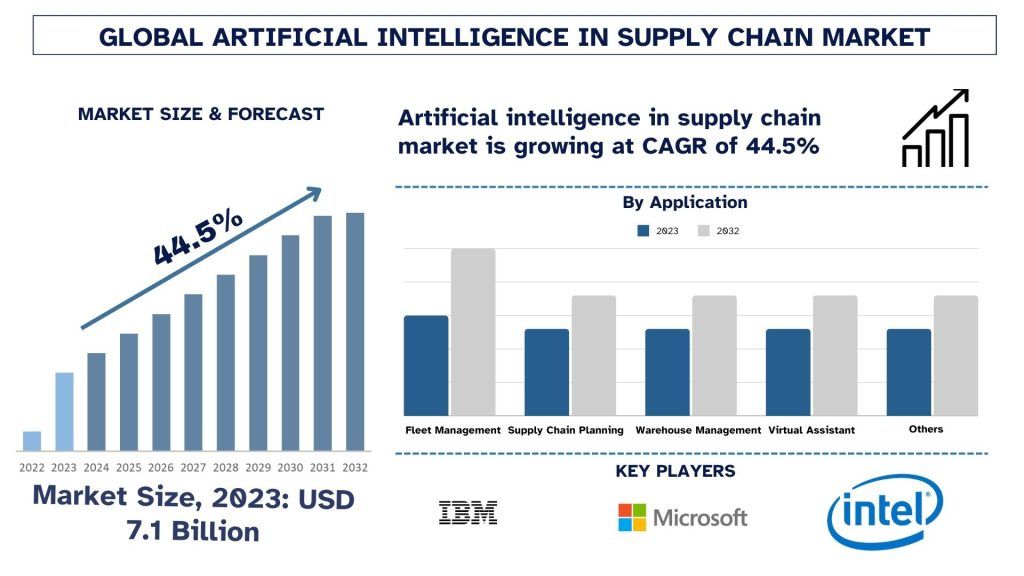
Artificial Intelligence in Supply Chain Market Size & Forecast
The Artificial Intelligence in Supply Chain market was valued at approximately USD 7.1 Billion in 2023 and is expected to grow at a robust CAGR of around 44.5% during the forecast period (2024-2032). The growth of the AI in supply chain market is driven by increasing demand for automation, real-time data analytics, and enhanced operational efficiency.
Artificial Intelligence in Supply Chain Market Analysis
AI in supply chains is helping to deliver the powerful optimization capabilities required for more accurate capacity planning, improved productivity, high quality, lower costs, and greater output, all while fostering safer working conditions. The growing adoption of artificial intelligence in the supply chain can be attributed to the growing adoption of AI. For instance, as per the press research, AI investments reached USD 881 Mn in the year 2020, globally. Furthermore, AI has been applied in a variety of end-use applications that allow businesses to function without the need for human supervision. AI-enabled machinery and equipment can work successfully by acquiring human abilities.
Artificial Intelligence in Supply Chain Market Trends
This section discusses the key market trends influencing Artificial Intelligence in Supply Chain segments as identified by our research experts.
Supply Chain Planning Category Transforming Industry
Based on application, the market is segmented into fleet management, supply chain planning, warehouse management, virtual assistant, and others. The supply chain planning segment is expected to achieve a significant CAGR during the forecast. The growing adoption of data-based decision-making and the increasing number of operations in a company require proper management, scheduling, and planning to manage the operations. AI helps in the decision-making and optimization of the industry’s resources.
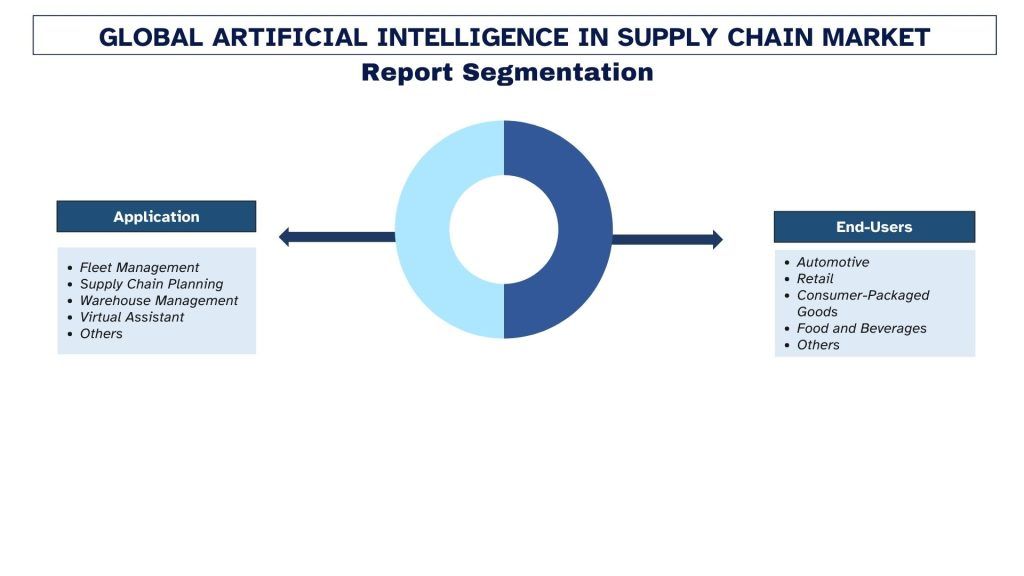
North America is expected to Dominate the Market.
The North American region is expected to dominate the artificial intelligence supply chain market. The growing adoption of artificial intelligence in the supply chain can be attributed to growing government initiatives toward the promotion and deployment of AI solutions. Furthermore, the growth of the e-commerce sector in countries including the U.S.A and Canada, growing investments in AI technology for productivity enhancement, the need for enhancing supply chain management, and a surge in the volume of real-time inventory data are contributing to the growth of the AI technologies market in supply chain industry in this region.
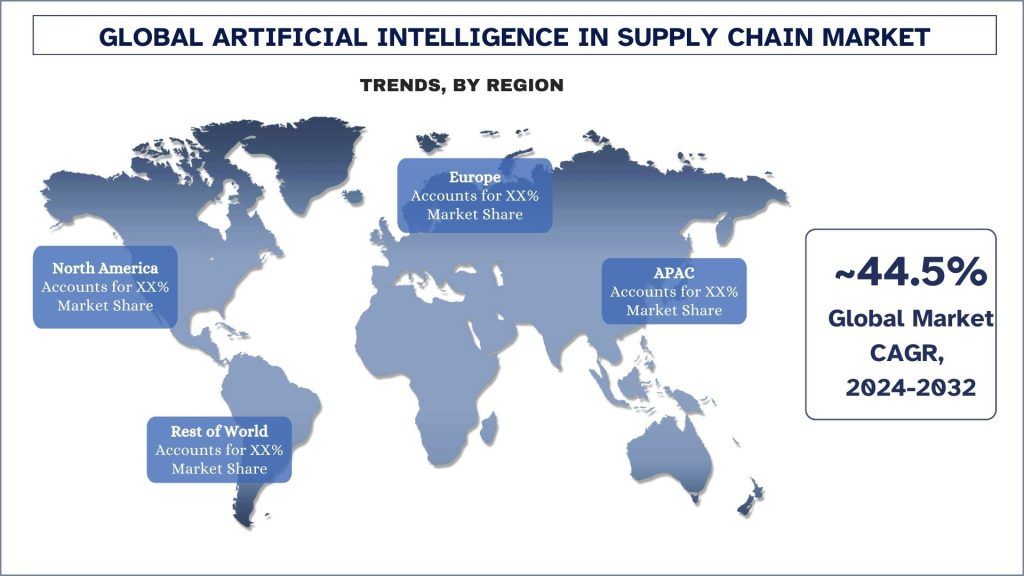
Artificial Intelligence in Supply Chain Industry Overview
Artificial Intelligence in the Supply Chain is competitive, with several global and international market players. The key players are adopting different growth strategies to enhance their market presence, such as partnerships, agreements, collaborations, new product launches, geographical expansions, and mergers and acquisitions. Some of the major players operating in the market are IBM, Microsoft, Google LLC, Amazon.com Inc., Intel Corporation, Nvidia Corporation, Oracle, SAMSUNG, Coupa Software Inc, SAP SE. Several M&As along with partnerships have been undertaken by these players to facilitate customers with hi-tech and innovative products/technologies.
Artificial Intelligence in Supply Chain Market News
- For instance, in 2023, The supply chain management company Blue Yonder announced that it had launched a new generative AI tool dubbed Blue Yonder Orchestrator within its Luminate Cognitive Platform.
Artificial Intelligence in Supply Chain Market Report Coverage
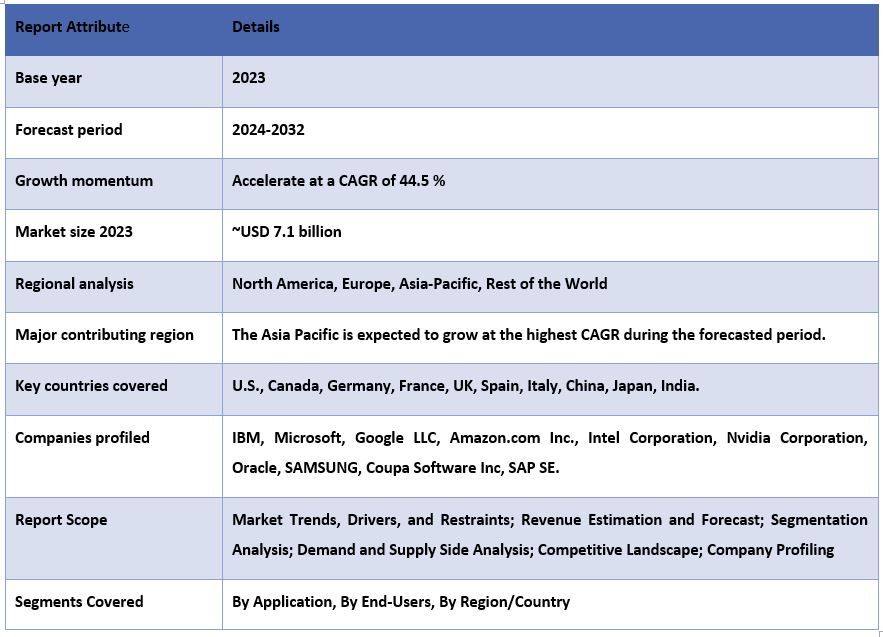
Reasons to buy this report:
- The study includes market sizing and forecasting analysis validated by authenticated key industry experts.
- The report presents a quick review of overall industry performance at one glance.
- The report covers an in-depth analysis of prominent industry peers with a primary focus on key business financials, product portfolios, expansion strategies, and recent developments.
- Detailed examination of drivers, restraints, key trends, and opportunities prevailing in the industry.
- The study comprehensively covers the market across different segments.
- Deep dive regional level analysis of the industry.
Customization Options:
The Global Artificial Intelligence in Supply Chain can further be customized as per the requirement or any other market segment. Besides this, UMI understands that you may have your own business needs; hence, feel free to connect with us to get a report that completely suits your requirements.
Table of Content
Research Methodology for the Artificial Intelligence in Supply Chain Market Analysis (2024-2032)
Analyzing the historical market, estimating the current market, and forecasting the future market of the global Artificial Intelligence in Supply Chain market were the three major steps undertaken to create and analyze the adoption of Artificial Intelligence in Supply Chain in major regions globally. Exhaustive secondary research was conducted to collect the historical market numbers and estimate the current market size. Secondly, numerous findings and assumptions were taken into consideration to validate these insights. Moreover, exhaustive primary interviews were also conducted, with industry experts across the value chain of the global Artificial Intelligence in Supply Chain market. Post assumption and validation of market numbers through primary interviews, we employed a top-down/bottom-up approach to forecasting the complete market size. Thereafter, market breakdown and data triangulation methods were adopted to estimate and analyze the market size of segments and sub-segments of the industry. Detailed methodology is explained below:
Analysis of Historical Market Size
Step 1: In-Depth Study of Secondary Sources:
A detailed secondary study was conducted to obtain the historical market size of the Artificial Intelligence in Supply Chain market through company internal sources such as annual reports & financial statements, performance presentations, press releases, etc., and external sources including journals, news & articles, government publications, competitor publications, sector reports, third-party database, and other credible publications.
Step 2: Market Segmentation:
After obtaining the historical market size of Artificial Intelligence in Supply Chain, we conducted a detailed secondary analysis to gather historical market insights and share for different segments & sub-segments for major regions. Major segments are included in the report, such as component, deployment, security type, and region. Further country-level analyses were conducted to evaluate the overall adoption of testing models in that region.
Step 3: Factor Analysis:
After acquiring the historical market size of different segments and sub-segments, we conducted a detailed factor analysis to estimate the current market size of the Artificial Intelligence in Supply Chain market. Further, we conducted factor analysis using dependent and independent variables such as component, deployment, security type, and Artificial Intelligence in Supply Chain regions. A thorough analysis was conducted of demand and supply-side scenarios considering top partnerships, mergers and acquisitions, business expansion, and product launches in the Artificial Intelligence in Supply Chain market sector across the globe.
Current Market Size Estimate & Forecast
Current Market Sizing: Based on actionable insights from the above three steps, we arrived at the current market size, key players in the global Artificial Intelligence in Supply Chain market, and market shares of the segments. All the required percentage shares split and market breakdowns were determined using the above-mentioned secondary approach and were verified through primary interviews.
Estimation & Forecasting: For market estimation and forecast, weights were assigned to different factors including drivers & trends, restraints, and opportunities available for the stakeholders. After analyzing these factors, relevant forecasting techniques i.e., the top-down/bottom-up approach were applied to arrive at the market forecast for 2032 for different segments and sub-segments across the major markets globally. The research methodology adopted to estimate the market size encompasses:
- The industry’s market size, in terms of revenue (USD) and the adoption rate of Artificial Intelligence in Supply Chain across the major markets domestically
- All percentage shares, splits, and breakdowns of market segments and sub-segments
- Key players in the global Artificial Intelligence in Supply Chain in terms of products offered. Also, the growth strategies adopted by these players to compete in the fast-growing market
Market Size and Share Validation
Primary Research: In-depth interviews were conducted with the Key Opinion Leaders (KOLs), including Top Level Executives (CXO/VPs, Sales Head, Marketing Head, Operational Head, Regional Head, Country Head, etc.) across major regions. Primary research findings were then summarized, and statistical analysis was performed to prove the stated hypothesis. Inputs from primary research were consolidated with secondary findings, hence turning information into actionable insights.
Split of Primary Participants in Different Regions
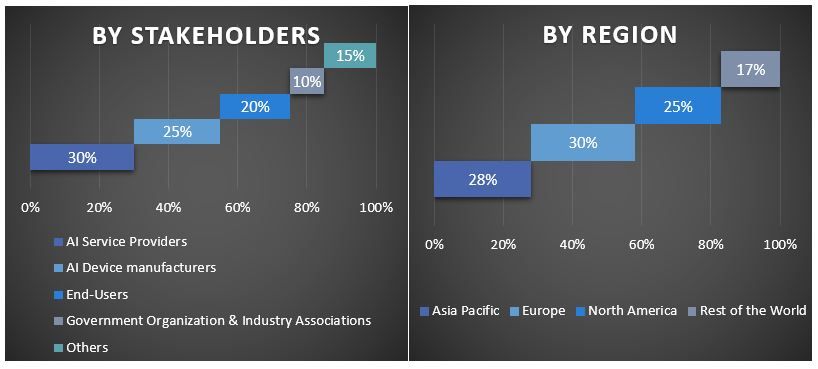
Market Engineering
The data triangulation technique was employed to complete the overall market estimation and to arrive at precise statistical numbers for each segment and sub-segment of the global Artificial Intelligence in Supply Chain. Data was split into several segments and sub-segments after studying various parameters and trends in the component, deployment, security type, and regions of the global Artificial Intelligence in Supply Chain market.
The main objective of the Global Artificial Intelligence in Supply Chain Market Study
The current & future market trends of global Artificial Intelligence in Supply Chain were pinpointed in the study. Investors can gain strategic insights to base their discretion for investments on the qualitative and quantitative analysis performed in the study. Current and future market trends determined the overall attractiveness of the market at a regional level, providing a platform for the industrial participant to exploit the untapped market to benefit from a first-mover advantage. Other quantitative goals of the studies include:
- Analyze the current and forecast market size of the Artificial Intelligence in Supply Chain market in terms of value (USD). Also, analyze the current and forecast market size of different segments and sub-segments.
- Segments in the study include areas of component, deployment, security type, and regions.
- Define and analyze the regulatory framework for Artificial Intelligence in the Supply Chain
- Analyze the value chain involved with the presence of various intermediaries, along with analyzing customer and competitor behaviors of the industry.
- Analyze the current and forecast market size of Artificial Intelligence in the Supply Chain market for the major regions.
- Major countries of regions studied in the report include Asia Pacific, Europe, North America, and the Rest of the World
- Company profiles of the Artificial Intelligence in Supply Chain market and the growth strategies adopted by the market players to sustain in the fast-growing market.
- Deep dive regional level analysis of the industry
Related Reports
Customers who bought this item also bought










